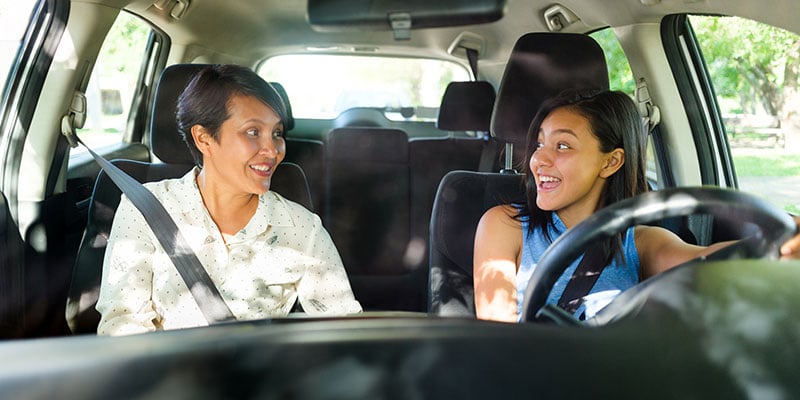
So, you’ve just received your driver’s license and are ready to hit the open road. Congratulations! You’re about to experience all the joy and freedom driving brings. We’re happy for you! But we also want you to be safe so you can enjoy driving for many years to come.
Here are 10 safe driving tips for new drivers:
Safe driving begins before you get on the road by learning all about your vehicle including how it handles at different speeds and in inclement weather. Get to know where your blind spots are and practice turning your head over your shoulder for complete visibility.
New drivers need to be familiar with the basic settings and how to operate their car’s lights, wipers, hazard lights, windshield defrost and safety features. Refer to your owner’s manual for anything you don’t understand.
Always use your seatbelt, even in parking lots or when you’re just traveling a short distance. Get into the habit of securing your seatbelt as soon as you sit in your car. Make sure that your passengers also fasten their seatbelts. Also, remember to secure any personal belongings and pets that may move around during your drive.
11.5 percent of Americans, roughly 25 million people, regularly drive without seatbelts. This increases the risk of fatality in an accident. It’s also linked to higher insurance rates for everyone on the road. Simply remembering to buckle your seatbelt is the first step to safe driving.
Even though the law allows a legal limit for blood alcohol levels (assuming you are of legal age), it may be better to avoid alcohol entirely. Alcohol slows your reflexes and impairs judgment. And if you get too carried away, you put your life and the lives of others at risk. You also risk losing your license and new driver insurance in the event of a DUI.
Impaired driving also includes the use of prescription medications or other substances that can affect your ability to drive safely. Even sleep-deprived new drivers put themselves at risk behind the wheel.
Anything that takes your attention and focus away from the road is considered a distraction. This includes things like eating or drinking, applying makeup, and of course, texting. Many states have adopted distracted driving laws that carry strict penalties.
But some distractions can be more subtle than you think. If you have a car full of noisy passengers and music blaring you’ll likely be more distracted. New drivers may minimize distractions by driving alone until they are used to their car and gain confidence behind the wheel.
Get into the habit of making all of your necessary adjustments before hitting the road. In other words, set your radio station, seat position, and air conditioning before you get going. That way you’re not fumbling with the dials while trying to drive.

Speeding has remained a main culprit for over two decades in fatal crashes. Speeding shortens your reaction time and endangers other drivers on the road. At higher speeds, you risk losing control of your car. Observe the posted speed limits and traffic signs that are directing you to reduce speed on curves or off-ramps.
Allowing plenty of time to get to your destination will help relax you as a new driver and you will not feel rushed and tempted to speed. Not following other cars too closely (tailgating) is part of maintaining a proper and safe driving speed. Driving at safe speeds will spare you costly speeding tickets and higher rates on new driver insurance.
This may seem like a no-brainer safe driving tip, but road signs give you valuable information and alert you when you’re approaching a school zone or potentially dangerous road conditions. You may encounter a stop sign unexpectedly or other signs that require you to adjust your speed or take another route.
Keeping your car maintained is an easy way for new drivers to ensure their safety. Regular oil changes, tires rotations and air levels, as well as tune-ups and other scheduled maintenance, will give you peace of mind.
Start a maintenance record file along with receipts of all your car repairs. A trusted mechanic can advise you on the particular needs of your car and when you’re due for service.
Intersections are busy and there is a lot going on. Pedestrians are crossing the street and other drivers are turning. When you are stopped at an intersection, wait for all the traffic to clear before you proceed.
One of the dangers in a busy intersection is other drivers speeding through yellow lights or running red lights. You may hit them if you don’t wait for the intersection to clear. Pedestrians may dart out in traffic or not be paying attention.
Bad weather can pose added challenges for new drivers, and learning to adapt to changing weather conditions can take some practice.
As a new driver, you’ll need to weigh the risks of venturing out in bad weather. If you can, stay put. But if you don’t have a choice, it’s best to learn some safe driving tips for traveling in adverse weather conditions. Here are some general guidelines:
Every new driver should store an emergency kit in their trunk with the basic essentials: jumper cables, ice scraper, flares, blanket, flashlight, map, bottled water and some non-perishable snacks. It’s also a good idea to include some first aid supplies.
Keep your emergency kit stocked with seasonal items for winter and summer such as extra water and blankets. Replenish anything you use right away to ensure that your kit will have everything you need in an emergency.
We hope you have enjoyed reading these safe driving tips. Remember, the more you practice safe driving, the easier it will become. Try to incorporate a few of these driving tips each time you hit the road. Happy driving!
Need to get a new insurance policy fast? We can give you a quote in just minutes! Get what you need to get back on the road today. Get a quote now!


Irvine, California
PO Box 7820
Newport Beach, CA 92658
Call us: 1-888-964-8556
No Comments Yet
Let us know what you think